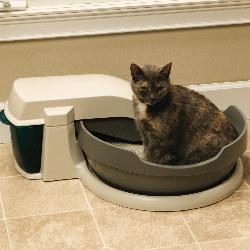
PetSafe® Expert
Gretchen Statz, DVM, DACVECC
Urinary Tract And Bladder Infection In Dogs & Cats
Urinary tract infections (UTIs) are a relatively common occurrence in dogs and cats. Infections in the urinary tract can occur in the bladder or can become serious and involve the kidneys. Most pets with urinary tract infections will have fairly classic symptoms and most UTI's can be treated relatively easily.
How do urinary tract infections develop?
The urinary bladder is connected to the outside word by a tube called the urethra. Bacteria from your pet's skin and fur can ascend up the urethra into the bladder. In rare occasions, the bacteria can travel further up the ureters and into the kidneys.
What are the symptoms of urinary tract infections?
Symptoms of UTI's could include bloody urine, straining to urinate, frequent urination, accidents in the house (dogs) or urinating in places other than the litter box (cats). Some animals will lick their vulvas and others will have no symptoms at all. If a kidney infection occurs, your pet may drink more water than usual and potentially feel very ill. Symptoms could include anorexia, lethargy, vomiting and/or abdominal pain.
Which pets get urinary tract infections?
Female animals are more likely to develop UTI's. Females have shorter urethras and so the bacteria have an easier time reaching the bladder. Some diseases also predispose animals to urinary tract infections such as diabetes (dogs or cats) or Cushing's disease (dogs).
How are urinary tract infections diagnosed?
A urinalysis is the first step in diagnosing a urinary tract infection. The urine sample might show blood, white blood cells or bacteria. In cases of kidney infection, the urine might be more dilute than usual. Urine samples for urinalysis can be obtained using a syringe and needle or via a "free catch" method using a clean bowel caught when your pet urinates.
The best way to truly diagnose a bacterial urinary tract infection is by culture and sensitivity of the urine. Culture should be performed sterilely using a syringe and needle directly into the bladder. This is a quick and easy procedure that does not significant discomfort. Most pets tolerate it well. The culture portion of the test will grow bacteria if present and the sensitivity portion will help your veterinarian determine which antibiotic would be best to use.
In cases where kidney infection is suspected, further testing including bloodwork and an abdominal ultrasound might be recommended.
What is the treatment for urinary tract infections?
Antibiotics are the main treatment for urinary tract infections. If it is a simple, first time urinary tract infection, your veterinarian may choose an antibiotic based on what usually works. The duration of treatment will likely be 10-14 days (5 days at the least).
With recurrent infections, your veterinarian will likely base the choice of antibiotic on a culture and sensitivity. The duration of treatment may be a bit longer (possibly up to a month). Kidney infections typically require even longer treatment for 6-8 weeks. The antibiotics are usually given orally at home and are once or twice daily in most cases. More serious kidney infections may require hospitalization for intravenous (IV) fluid therapy and IV antibiotics for anywhere from 3 days to as long as a week.
What if my pet keeps getting urinary tract infections?
Recurrent urinary tract infections can occur for various reasons. Your pet may have stones in the bladder and/or kidneys that are contributing to infection. There may also be an underlying disease process (e.g. Cushing's or diabetes) that is predisposing your pet to infection. Some dogs have excess skin and fat over their vulva that allows bacteria to become trapped and move into the bladder more easily. And in some cases the bacteria become more resistant and continue to grow despite treatment with antibiotics.
If your pet develops recurrent urinary tract infections, the culture and sensitivity becomes extra important to see if the bacteria are becoming more resistant to the antibiotics. Your veterinarian may also consider running additional tests including x-rays, ultrasound and/or bloodwork.
Can urinary tract infections be prevented?
In general there are no specific preventative measures to take unless your pet has recurrent infections. If recurrent infections occur, your veterinary may elect to add certain supplements to make bacterial infections less likely to occur and to strengthen your pet's immune system.
Providing your pet with water fountains and lots of clean water bowls throughout the house can help keep your pet hydrated and help prevent urinary issues.
Are urinary tract infections contagious?
Urinary tract infections are not contagious from pet to pet or from pets to people. If multiple pets in the home develop a urinary tract infection, it is likely just coincidence.
So if your pet develops signs of a urinary tract infection such as straining to urinate, urinating a lot, or urinating in the house if they were previously potty trained pet, see your veterinarian.
Get Email Updates
Subscribe to the latest news, promotions, & more from PetSafe® brand.
Sign up today for the latest news, promotions, and more from PetSafe® brand.






